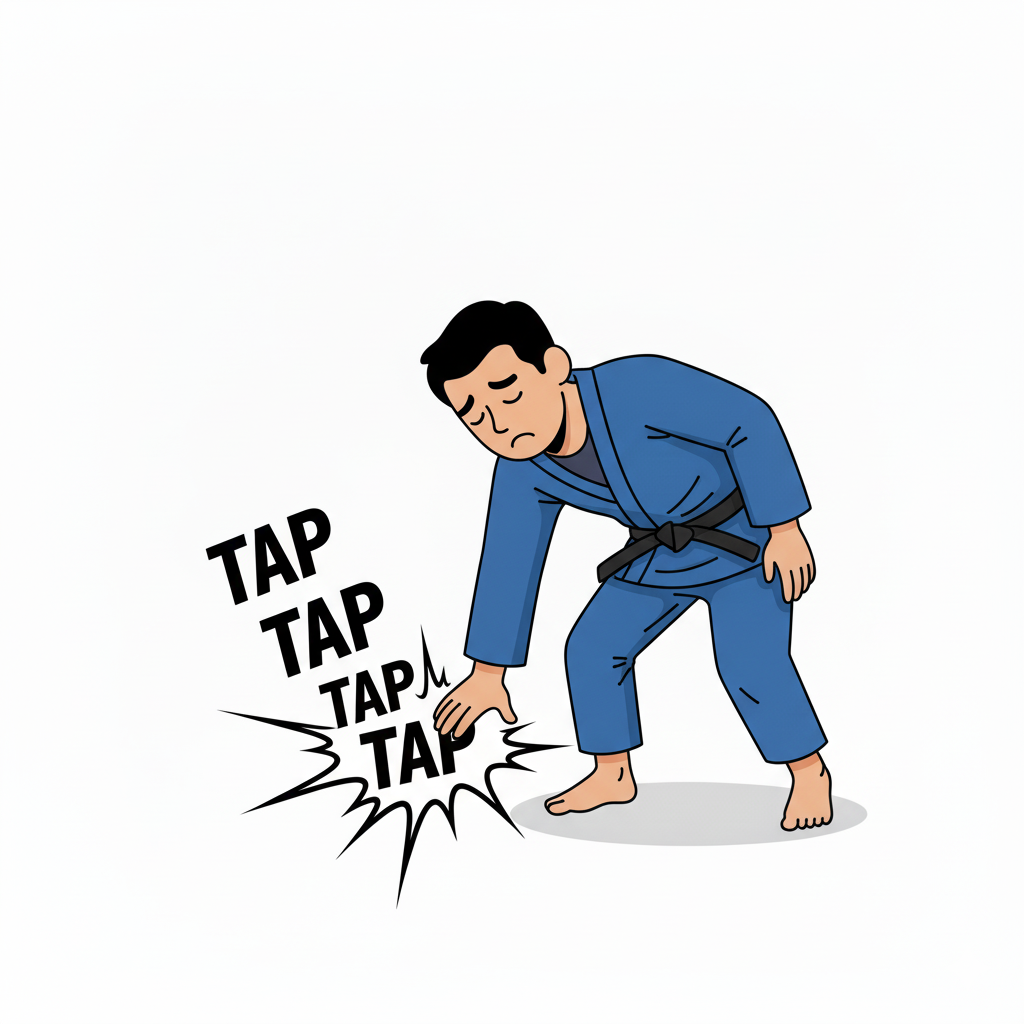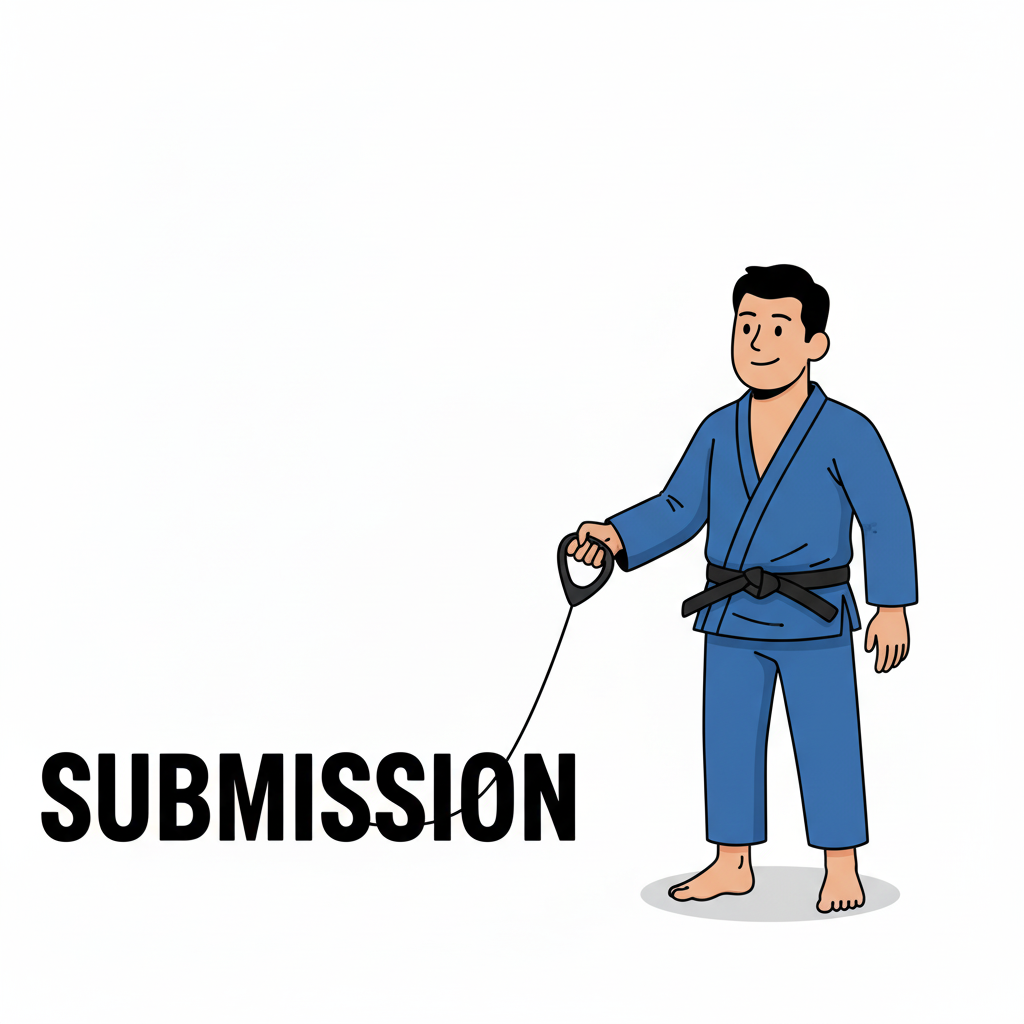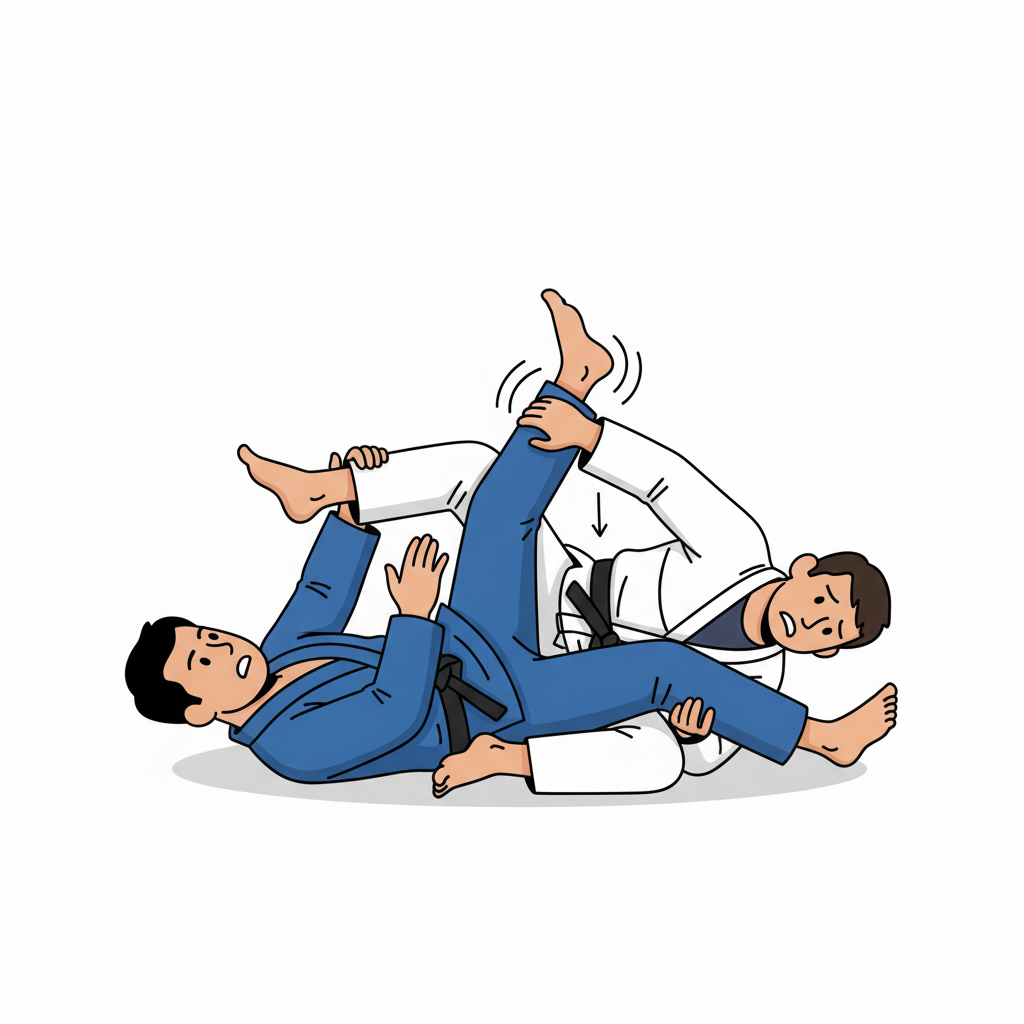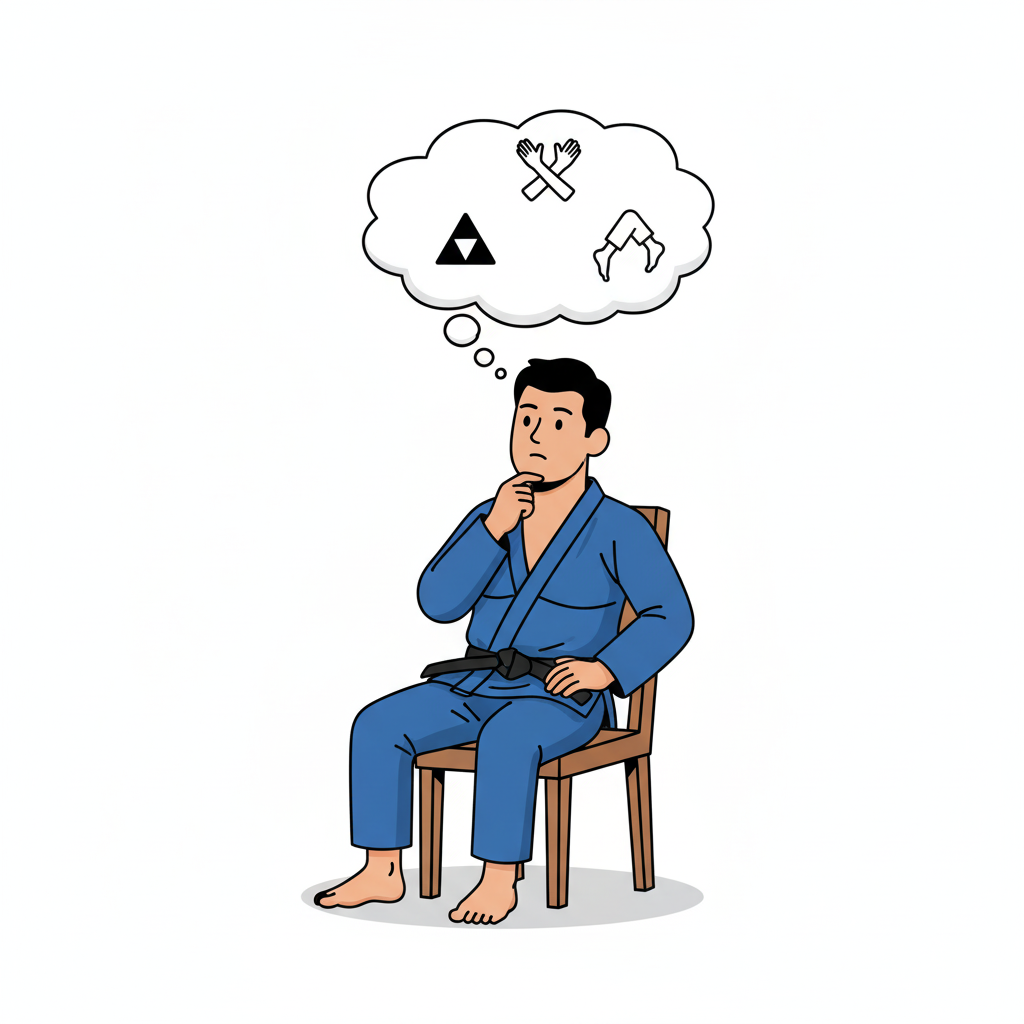The Definitive BJJ Submissions Directory and Knowledge Base
Master the art of finishing fights with joint locks and chokes. Learn to apply submissions safely and effectively across all positions.

A Foundation of Control: Understanding BJJ Submissions
The Goal of Submission Grappling: Tap or Loss of Consciousness/Limb
The act of "tapping out" is the cornerstone of BJJ etiquette and safety. When you are caught in a submission hold that you cannot escape, you signal defeat by tapping your opponent or the mat, or by verbally saying "tap."

The goal of every submission is to achieve one of three outcomes:
- 1Forced Surrender (The Tap):
The opponent taps out to prevent pain, injury, or loss of consciousness.
- 2Loss of Consciousness (The Choke):
A blood choke is applied with such efficiency that the opponent loses blood flow to the brain and passes out. This is a common, decisive finish in competition.
- 3Structural Damage (The Break):
A joint or compression lock is applied with force and speed that, without a tap, would result in a broken bone, ligament tear, or other debilitating injury.
In BJJ, the ability to control your opponent and secure the submission is the truest measure of technical mastery.
Why Positional Control is Essential for Submissions
A common mistake for beginners is to submit as soon as a favorable position appears. Advanced practitioners know that submissions are the consequence of superior control, not the goal.
You won't be able to finish a high-level submission, especially against a strong opponent, if they can move freely, create space, or use their limbs for support. That's why BJJ strategy always follows a clear sequence:
Mastering positions like Mount, Back Control, and Side Control allows you to strip away your opponent's defensive options, isolate their limbs, and apply the pressure needed for a clean, safe, and effective finish. Submissions attempted from poor positions often fail and put the attacker at risk of being swept or having their own position taken.
The Legal Landscape: IBJJF vs. EBI Rulesets
The specific submissions you are legally allowed to use depend entirely on the ruleset of the competition you are in. BJJ has a fractured competitive landscape, but the two most important rule standards to understand are those set by the International Brazilian Jiu-Jitsu Federation (IBJJF) and the Eddie Bravo Invitational (EBI), which represents the no-gi, sub-only approach.
IBJJF (Point-Based)
Traditional Gi and No-Gi
Highly restrictive, especially for lower belts. Heel Hooks, Knee Reaping, and most small joint manipulation are generally banned at most levels.
EBI (Submission-Only)
No-Gi
Very permissive; allows nearly all submissions, including advanced leg locks like the Heel Hook. The match only ends via submission, or goes to an Overtime system.
This difference is important. Most of the advanced or risky submissions, especially those that twist the knee or ankle, are not allowed in traditional IBJJF competitions. However, they are common in most professional no-gi events.
The High-Percentage BJJ Submission Arsenal (Most Effective List)
While the complete catalog of BJJ submissions is vast (as you'll see in the next section), success in grappling comes from mastering a small, effective core. High-percentage submissions are those that are easy to enter, offer strong control, and boast a proven track record for finishing opponents at every level of competition.
The Essential 10 Submissions for Beginners
If you're new to the mat, avoid getting overwhelmed by exotic moves. Focus your training time on these ten fundamental submissions. They form the basis of almost all grappling offense, and most advanced techniques are simply variations or follow-ups to them.
Rear Naked Choke (RNC)
Blood Choke • Back Control
The King of Submissions; it has the highest finish rate in all of grappling.
Triangle Choke
Blood Choke • Guard/Mount
The quintessential BJJ move; teaches hip control and leg dexterity.
Arm Bar
Hyperextension Joint Lock • Guard/Mount/Side Control
The first joint lock learned; highly versatile and forms the basis of many submission chains.
Kimura
Rotational Joint Lock • Side Control/Half Guard
The strongest shoulder lock, also a phenomenal control and sweeping tool.
Americana
Hyperextension Joint Lock • Side Control/Mount
Simple shoulder lock, often used as a bait to set up the Arm Bar.
Guillotine Choke
Air Choke • Front Headlock/Guard
Excellent counter to takedowns and is a high-percentage move in No-Gi.
Cross Collar Choke
Gi Choke • Mount/Guard
The most fundamental Gi choke; teaches effective sleeve and lapel grips.
Ezekiel Choke
Gi Choke • Mount/Inside Guard
A powerful choke using the sleeve; effective even against defensive opponents.
Straight Ankle Lock
Hyperextension Joint Lock • Ashi Garami
The safest entry into the leg-lock game and often allowed at all belt levels.
Bow and Arrow Choke
Gi Choke • Back Control
An extremely powerful, non-reliant-on-hand-strength choke.
Gi vs. No-Gi Submissions: Key Differences in Application
The uniform you wear fundamentally changes the submission landscape. The heavy cotton fabric of the Gi provides friction, grips, and weapons, while the slickness of No-Gi grappling forces reliance on pure body mechanics and skeletal leverage.

Gi: Submissions
Submissions are often slower, more controlled, and involve leveraging the fabric. Collar chokes (Cross Collar, Paper Cutter, Loop Choke) and the Bow and Arrow dominate. The Ezekiel Choke is a high-percentage equalizer that works even when trapped inside the opponent's guard.

No-Gi: Submissions
Submissions are faster, more dynamic, and highly reliant on specific head and arm control. Skeletal attacks like the D'Arce, Anaconda, and Guillotine chokes thrive, along with a heavy emphasis on Leg Locks (e.g., Heel Hooks, Toe Holds) that are often easier to isolate without the grip-fighting of the Gi.
Winning Strategies: Submissions with the Highest Finish Rate
Looking at high-level competition data across promotions like the UFC, ADCC, and IBJJF World Championships, a few finishes consistently stand above the rest. Mastering the entries and control mechanics for this elite group will maximize your finishing potential.
Rear Naked Choke (RNC)
The undisputed king. Because the opponent's back is considered the best position in grappling, securing the RNC is the ultimate outcome of dominant positional control. It's safe, requires minimal strength, and only requires securing the back.
Arm Bar
The most submitted joint lock. Its versatility allows it to be applied from the guard, mount, side control, and even in transitions. The most common sequence is the Arm Bar → Triangle → Omoplata chain.
Heel Hook
In No-Gi grappling, the Heel Hook is arguably more effective than the RNC. It attacks the knee joint by rotating the heel, putting immense torque on the joint. Because the setup is fast and the damage is instantaneous, it has a terrifyingly high tap rate in sub-only formats.
Triangle Choke
A staple that is consistently effective in both Gi and No-Gi. Its success comes from its nature as a control position first. When locked in correctly, the attacker controls the opponent's posture, shoulders, and head, making escape extremely difficult.
Submission Mechanics: The Core Categories
Joint Locks: Precision, Leverage, and Breaking Mechanics
A joint lock (or joint manipulation) is any hold that seeks to compromise the integrity of a joint by forcing it into or past its natural range of motion. Joint locks rely on two main principles:
- Leverage:
Using a small amount of force against a long lever (an arm or leg) to create immense pressure at the fulcrum (the joint).
- Isolation:
Trapping the joint so that the opponent cannot use their whole body to relieve the pressure or escape.
Joint locks are further categorized by the direction of the force applied: hyperextension or rotation.
Hyperextension Locks: Arm Bars, Knee Bars, Straight Ankle Locks
Hyperextension locks force a joint to extend beyond its natural endpoint, typically by pushing the limb forward or backward. They target the main hinge joints of the body—the elbow, knee, and ankle—and are often the first joint locks taught due to their relative safety when controlled.
- Target:
Hinge joints (elbow, knee, ankle).
- Mechanism:
Applying pressure perpendicular to the joint to push it past the natural limit.
- Examples:
The Arm Bar (elbow hyperextension), the Knee Bar (knee hyperextension), and the Straight Ankle Lock (hyperextension of the ankle/achilles tendon).
Rotational Locks: Kimuras, Omoplatas, Toe Holds
Rotational locks (or torsional locks) apply a twisting force to a joint, often targeting ball-and-socket joints like the shoulder or small joints like the wrist. These are typically considered more dangerous as the twisting motion can be harder for the opponent to immediately defend and often results in ligament damage before pain is registered.
- Target:
Ball-and-socket joints (shoulder, hip) and small joints (ankle, wrist).
- Mechanism:
Applying a rotational or twisting force to the joint.
- Examples:
The Kimura and Omoplata (both torque the shoulder), the Toe Hold (twists the ankle/heel), and the Twisting Wrist Lock (twists the wrist joint).
Compression Locks: Bicep Slicers, Calf Slicers
Compression locks are a distinct category that uses a bony part of the attacker's body (like the shin, forearm, or wrist) to press directly into a muscle, tendon, or nerve cluster of the opponent. These are extremely painful and are often illegal in IBJJF competition because they do not rely on a tap to prevent damage—they cause muscular or soft tissue injury directly.
- Target:
Muscle tissue and ligaments (bicep, calf, ribs).
- Mechanism:
Using a sharp edge (bone) to compress the soft tissue against another bone (e.g., slicing the bicep against the humerus).
- Examples:
Bicep Slicers (forearm blade against the bicep muscle) and Calf Slicers (shin bone against the calf muscle).
Chokeholds: Control, Constriction, and The Finish
Chokeholds target the neck and are considered the most effective and decisive finishes in grappling because they render the opponent unconscious without causing permanent damage (when released promptly). Chokes are divided based on what part of the neck they target: the arteries or the windpipe.
Blood Chokes (Vascular): Rear Naked Choke, Triangle, D'Arce
Blood chokes, or vascular chokes, are the ultimate goal of BJJ. They work by applying pressure to the carotid arteries on either side of the neck. This pressure stops the flow of oxygenated blood to the brain, causing the opponent to rapidly lose consciousness (pass out) in a matter of seconds.
- Mechanism:
Two points of pressure constrict the carotid arteries, cutting off blood flow to the brain.
- Key Advantage:
They require minimal strength and are highly efficient and safe.
- Examples:
Rear Naked Choke (RNC), Triangle Choke, and the D'Arce Choke.
Air Chokes (Respiratory): Guillotines, Arm-In Chokes (Less Common)
Air chokes, or respiratory chokes, are less common and less desirable than blood chokes. They work by pressing against the trachea (windpipe), blocking the opponent's ability to breathe. While effective, they are slower to finish, require significantly more force, and can cause injury to the larynx (windpipe). A poorly applied blood choke often degrades into an air choke.
- Mechanism:
Direct pressure on the trachea (windpipe) and larynx.
- Key Disadvantage:
Slower, requires more pressure, and can cause minor injury.
- Examples:
Certain variations of the Guillotine Choke (where the arm is improperly placed directly over the windpipe) and some specialized Arm-In Chokes.
Gi Chokes: Cross Collar, Bow and Arrow, Paper Cutter, Ezekiel
This is a specific subcategory of chokes that utilizes the stiff lapel and sleeve material of the Gi to apply blood or air constriction. The fabric acts as a powerful, non-slip "rope" or "handle" to tighten the choke.
- Mechanism:
Utilizing the Gi fabric as a leveraging tool to apply constriction to the neck.
- Examples:
Cross Collar Choke (uses two lapels), Bow and Arrow Choke (uses one lapel and a sleeve), Paper Cutter Choke (uses one lapel), and the Ezekiel Choke (uses the sleeve cuff/forearm).
The Complete Jiu Jitsu Submissions Catalog (The Directory)
Dive deep into our comprehensive submission catalog, meticulously organized by mechanical category. Each submission type houses a collection of specific techniques with detailed breakdowns of mechanics, setup strategies, and step-by-step application methods. Click any category below to explore the individual submissions within that family, from basic entries to advanced variations.
Application and Strategy: Submitting from All Positions

Submissions from the Guard (Closed, Open, Half Guard)
The Guard is often a defensive or neutral position, but it is also a powerful offensive launchpad for submissions. The key strategy here is off-balancing and isolating. Since you are on the bottom, you must use your legs to control distance and create acute angles.
Closed Guard
The focus is on high-control, low-risk chokes and joint locks that use the power of the legs.
High-Percentage Moves: Triangle Choke and Arm Bar
Open Guard (Spider, De La Riva, Lasso)
The control is primarily focused on the opponent's limbs. Submissions are often used as a threat to force a reaction.
High-Percentage Moves: Omoplata and Guillotine
Half Guard
Submissions from the bottom of half guard are challenging. They focus on controlling one side of the opponent's body.
High-Percentage Moves: Kimura and D'Arce Choke

The Control-to-Submission Pipeline from Top Positions (Mount, Side Control, Knee on Belly)
When you are on top, the strategy shifts entirely to maintaining crushing pressure and eliminating escape paths. Submissions from top control are the most reliable because the opponent is pinned and must devote all energy to escaping the pin, creating moments of vulnerability for the submission attack.
The typical pipeline for finishing from the top is: Pin → Pressure → Isolate → Finish.
Mount
Considered the most dominant pin. The focus is on the neck and arms.
High-Percentage Moves: Cross Collar Choke, Ezekiel Choke, Arm Bar
Side Control
Excellent for attacking the near-side shoulder.
High-Percentage Moves: Americana, Kimura, Paper Cutter Choke (Gi)
Knee on Belly (KOB)
The pressure forces an opponent to turn and expose their back or arms. Submissions here are often transitions.
High-Percentage Moves: Arm Bar, transition to Back for RNC

The Leg Lock Game: Submitting from the Bottom (Ashi Garami, Outside Heel Hook)
The modern BJJ landscape has been revolutionized by leg locks. The strategy here is unique: it involves sacrificing traditional positional control for the immediate threat of a major joint break. The primary position for all serious leg attacks is the Ashi Garami (leg entanglement family).
Ashi Garami
A foundational control position where you isolate one of your opponent's legs. This is the Side Control of the leg game.
From here, you have total control over the direction of the knee and ankle.
Outside Heel Hook
The highest percentage finish in No-Gi. It is applied by securing the heel and twisting, torquing the knee.
Key Principle: Positional Hierarchy is Reversed
While traditional BJJ seeks the back, the leg lock game prioritizes securing the ankle/knee. The risk is high, but the potential for an immediate finish is equally high.

Building Submission Chains and Sequences (The Armbar → Triangle → Omoplata Flow)
The ultimate strategy for a high-level grappler is never committing to a single submission. Opponents are trained to escape common moves. Instead, the attacker initiates a submission chain—a series of connected, complementary attacks. If the opponent defends the first attack, their reaction will inevitably create an opening for the second or third.
The Arm Bar → Triangle → Omoplata Flow
The classic chain from the guard. When the opponent pulls their arm out of the Arm Bar, you use that space to trap their head and shoulder in a Triangle Choke. If they posture out of the Triangle, transition to an Omoplata.
The Anaconda → D'Arce Chain
A powerful No-Gi sequence. If the opponent defends the Anaconda by pulling their head out, you use the same control to immediately attack the other side of the neck with the D'Arce Choke.
Mastering Transitions
Mastering these fluid transitions is the difference between a grappler who attempts submissions and one who finishes them.
Frequently Asked Questions (The BJJ Submissions Knowledge Base)
Master the art of finishing techniques and when to apply them